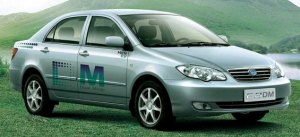
R&D center: Shanghai, Shenzhen
Main assembly plants: Xi An, Shenzhen
2015: 455,400 units
2014: 437,900 units
2013: 506,200 units
2012: 420,000 units
2011: 437,000 units
2010: 519,800 units
2009: 448,000 units
2008: 170,000 units
2007: 85,942 units
2006: 55,038 units
2005: 16,000 units
2016 domestic sales by model:
F0: 10,865 units
F3: 130,114 units
Surui: 33,539 units
G5: 4,562 units
E5: 15,639 units
Qin: 32,524 units
S6: 1,928 units
E6: 20,605 units
Yuan: 45,838 units
Song: 100,042 units
S7: 65,360 units
Tang: 31,405 units
Reference:
http://www.qqbenz.com/
http://www.qichexl.com/a/xiaoliangpaixing/
Nevertheless, BYD does grow rapidly in the domestic market. It even attracted American investor Warren Buffett to acquire 10% of its stakes, thanks to the prospect of its battery technology. Before entering car production, BYD was already a world-leading mobile phone battery supplier. This give it a strong advantage in develping hybrid and electric vehicles. In late 2008, it stunned the world by introducing the world's first mass production plug-in hybrid vehicle, F3DM, beating the likes of Chevrolet Volt and Toyota Prius Mk4. No wonder Buffett described it as "a small company with big ambition". How big? BYD set a goal to become the No. 1 car maker in China by 2015 and No. 1 globally by 2025, believe or not!
In 2003, foreseeing the bright prospect of car industry, the company decided to enter car production business by purchasing an existing car maker, Qinchuan Auto of Xian. Through capitalization from the Hong Kong stock market, it invested into expanding the Xian factory and development of its new compact sedan, F3. This car closely modelled the contemporary Toyota Corolla, even though BYD claimed it developed the car by itself. Its engines were sourced from Mitsubishi. It would become one of the best selling models in its segment and a core model of the company.
 F3DM (2008) - world's first production
plug-in hybrid car
F3DM (2008) - world's first production
plug-in hybrid carIn the next few years, more Japanese clones arrived: the F6 sedan mirrored Honda Accord, while F0 minicar was a carbon-copy of Toyota Aygo. BYD still claimed they were self-developed, but no matter exterior & interior design, dimensions and mechanical layouts were also identical to their donor cars. It once again proved that China was still lack of protection for intellectual properties.
Nevertheless, in the late 2000s BYD began showing some originality. Its S8 coupe cabriolet might look like Mercedes CLK-class from the front, but it was essentially new elsewhere. Its M6 MPV was a clean sheet design. It also developed its own 4-cylinder family engines and plug-in hybrid powertrain. The latter made debut in F3DM (Dual-Mode) in late 2008 and became the world's first mass production plug-in hybrid car. As BYD has strong advantage in rechargeable battery technology and production, it set its sight on the fast-growing hybrid and electric car market expected in 2010s.